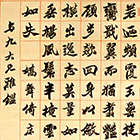Japanese Archaeology and Special Exhibition (Heiseikan) Thematic Exhibition Room
October 8, 2013 (Tue) - December 1, 2013 (Sun)
During the Qing dynasty, with the rise of the study of ancient texts, epigraphs gained attention in the field of calligraphy. Inscriptions on bronzes and stone monuments became favored over conventional copybooks printed from the works of calligraphy masters such as Wang Xizhi. The group of scholars who focused on epigraphs is called the Stele school, and is distinguished from the Copybook school, which was the mainstream before the rise of the Stele school.
The Stele school scholars were originally interested in calligraphic works written in Tang-dynasty regular script and Han-dynasty clerical script. They subsequently began to examine bronzes and stone monuments buried in fields and mountains, and formed new calligraphic styles, including a rustic regular script, clerical script and seal script.
The Stele school became the mainstream of Qing-dynasty calligraphy after scholars, such as Ruan Yuan and Bao Shichen, advocated a theory praising epitaphs created in the Northern Wei dynasty.
As part of the 11th collaborative exhibition among the Tokyo National Museum, the Taito City Calligraphy Museum, and the Asakura Museum of Sculpture, Taito City, which joined in the collaboration this year, this exhibition overviews the development of the Stele school and introduces the school's major calligraphers' representative works with a focus on the school's sudden rise to eminence.
This joint exhibition showcases the attraction of calligraphy of the Qing-dynasty Stele school, which appeared, based on academic studies, as a new phase in the history of calligraphy.

